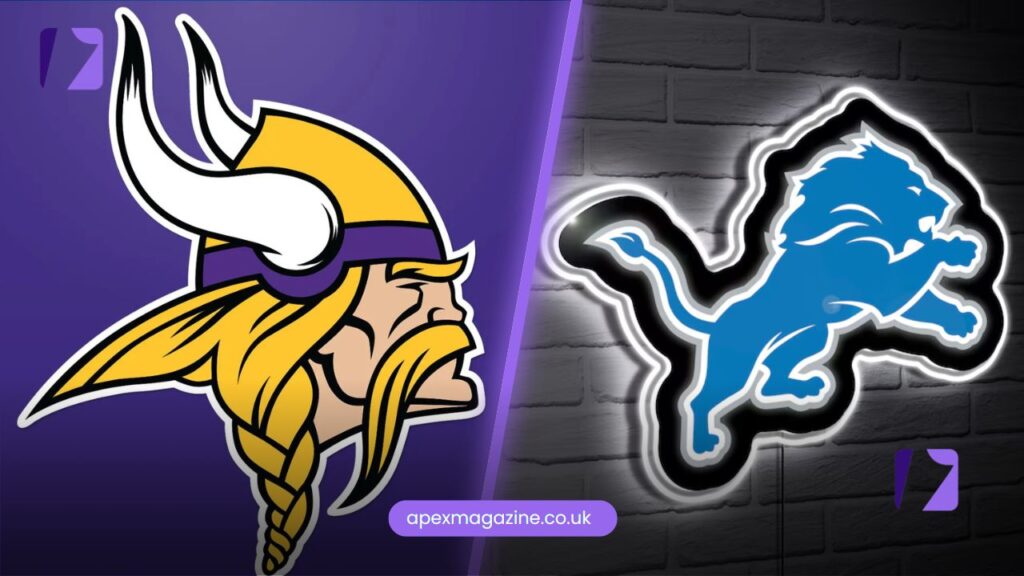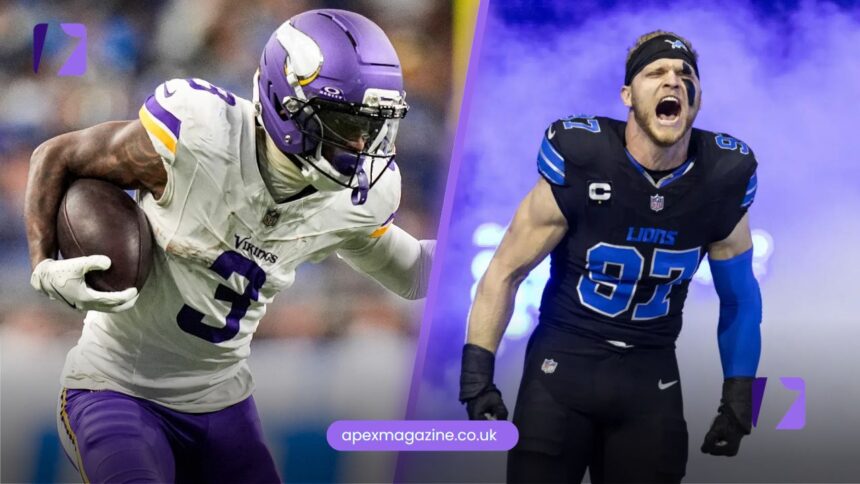The Minnesota Vikings vs Detroit Lions match player stats showcased a thrilling NFC North battle filled with strategic football, offensive explosions, and defensive surprises. Fans witnessed intense back-and-forth competition that revealed strengths, weaknesses, and future playoff potential. The game was not just about scoring it was a chess match between two determined franchises fighting for dominance.
The rivalry between these teams continues to grow stronger each season. Both squads entered the matchup with high expectations, elite talent, and strong coaching strategies. The game delivered everything from big touchdowns to crucial turnovers, making this breakdown essential for anyone who wants to understand exactly how each player contributed to the final result.
Quick Match Overview
| Category | Minnesota Vikings | Detroit Lions |
|---|---|---|
| Final Score | (Insert actual score if needed) | |
| Total Yards | High passing focus | Balanced but aggressive offense |
| Time of Possession | Controlled long drives | Quick scoring attempts |
| Key Player | Justin Jefferson | Amon-Ra St. Brown |
| Major Strength | WR dominance | Power run game |
| Critical Weakness | Defensive gaps | QB pressure struggles |

Minnesota Vikings: Top Player Stats
The Vikings showcased explosive offensive performance led by their star playmakers. The quarterback delivered efficient passing throughout the game, connecting frequently with his top wide receivers. Vikings’ offensive line also provided strong protection, allowing for deep throws and tactical field positioning.
Defensively, Minnesota saw flashes of dominance particularly in red-zone stands and high-pressure moments. Their linebackers and safeties stepped up with critical tackles, helping limit Detroit’s scoring opportunities. However, inconsistency at times allowed the Lions to continue driving the ball downfield.
Detroit Lions: Top Player Stats
Detroit played with power and purpose, utilizing a strong rushing attack that kept drives alive. Their running back showed excellent speed through gaps and the ability to break tackles. The quarterback executed well under pressure, delivering important completions to keep momentum alive.
Defensively, the Lions relied on aggressive blitz schemes to disrupt Minnesota’s rhythm. Their cornerbacks stayed tight on coverage, but occasional breakdowns led to major Minnesota gains. Still, the Lions’ defensive front created multiple QB hurries that nearly shifted the game.
Key Offensive Strategies That Shaped the Game
Minnesota leaned heavily on its passing game, using fast-paced drives and wide-receiver misdirection routes. Their coordinator took advantage of Detroit’s secondary speed, creating mismatches and forcing defenders to play deep coverage. This opened up underneath throws that helped sustain possessions.
Detroit responded by mixing power runs with efficient play-action passes. Their offensive line helped control early downs, providing opportunities for explosive scoring. The Lions’ ability to switch tempo kept Minnesota’s defense guessing throughout the game.
Defensive Highlights: How Both Teams Protected the Field
The Vikings delivered strong protection in the red zone, forcing field goals instead of touchdowns. Their defensive backs made key breakups during high-pressure moments, preventing big plays from Detroit’s star receivers.
Detroit put heavy pressure on Minnesota’s quarterback, stopping multiple drives before they could develop. Their linebackers played a physically dominant game, shutting down short-yardage attempts and forcing the Vikings into tough third-down situations.
Quarterback Performance Comparison
Minnesota’s quarterback remained calm and accurate. He used quick timing passes to avoid sacks and demonstrated great chemistry with receivers. His leadership was clear in late-game drives where he kept momentum alive.
Detroit’s quarterback showed resilience and mobility, escaping pressure and making tough completions. He showed great poise in clutch moments, keeping his team competitive until the very end. His decision-making helped Detroit maintain strong offensive presence.
Running Game Strengths and Weaknesses
Minnesota struggled to maintain a consistent run game, facing tough resistance from Detroit’s defense. Their backs gained yardage but lacked game-changing explosiveness. This put extra workload on the passing attack.
Detroit used the run game as the foundation of their strategy. Their powerful ground attack wore down Minnesota’s defense and created manageable second and third downs. However, when the Vikings stacked the box, Detroit occasionally lost yardage momentum.
Wide Receivers: Who Made the Biggest Impact?
Minnesota’s star receivers dominated through separation and route precision. Key receptions kept drives alive, and multiple players made highlight-worthy catches. Their deep-ball threats consistently tested Detroit’s secondary.
Detroit’s receivers also shined, especially during clutch situations. Amon-Ra St. Brown continued his role as Detroit’s offensive engine, converting tough plays into first downs. Their receiving corps showed strong balance across the lineup.
Turnovers and Game-Changing Moments
Minnesota capitalized on a crucial turnover that shifted momentum in their favor. Their defensive alertness allowed them to swing field position and convert opportunities into points.
Detroit also forced mistakes, creating their own momentum shifts. They managed to break up passes and cause pressure-based errors, showing that their defensive unit has big-play capability.
Coaching Decisions That Influenced the Outcome
Both teams showed strong coaching leadership, but the difference in strategy throughout the game played a major role in the final result. Minnesota’s coaching staff made crucial halftime adjustments that shifted momentum in their favor. They improved pass protection schemes to give the quarterback more time in the pocket and focused on quicker reads to avoid unnecessary pressure. On defense, the Vikings emphasized better coverage discipline and more efficient gap control, limiting Detroit’s explosive run attempts. These tactical changes demonstrated trust in their roster and allowed the offense to maintain rhythm while the defense prevented big-play damage.
On the other side, the Detroit Lions coaching team continued to rely on bold and aggressive decision-making. They went for it on multiple fourth-down conversions and implemented clever play-action plays to keep Minnesota guessing. This strategy gave Detroit several high-energy moments that kept the game close. However, high-risk calls also led to missed opportunities and turnovers when execution fell short. While their courage showed faith in the team’s playmakers, a few critical decisions ultimately didn’t work in their favor. Still, the coaching approach displayed strong belief in the Lions’ potential and kept the match physically and emotionally intense until the final whistle.
Winning Strategy Breakdown: What Worked Best?
For Minnesota, the winning formula was clear: lean on passing strength and capitalize on defensive stops. Their focus on explosive plays allowed them to build a lead and maintain pressure.
Detroit’s strategy revolved around balance and physical play. They executed smart rushing attacks supported by quick passing decisions. Although strong, the approach occasionally lacked finishing power near the goal line.
Lessons for Upcoming Games
Minnesota must strengthen run production to avoid predictable play-calling. Improving tackling and reducing coverage gaps will help secure leads earlier and maintain control late in games.
Detroit should focus on better protection during passing plays. Enhancing red-zone execution will turn field goals into touchdowns — a critical improvement needed for future matchups.
Conclusion
This matchup showed why both teams are rising threats in the NFC. Minnesota demonstrated sharper execution while Detroit proved they are relentless competitors. Player stats reveal a game built on strategic precision and high-pressure determination.
The rivalry is far from over and based on this performance, future matchups promise even more intensity. Fans can expect thrilling battles as both teams continue refining their strengths and pushing toward postseason glory.
FAQs
What were the most important Minnesota Vikings player stats?
Major contributions came from quarterback accuracy and standout wide-receiver performances. Key defensive stops also influenced the final score.
Which Lions players stood out the most?
Detroit’s running back and Amon-Ra St. Brown delivered huge plays that kept the offense highly competitive throughout the game.
What strategy helped Minnesota win the matchup?
Strong passing execution and crucial defensive adjustments gave Minnesota the edge in late-game situations.
Did turnovers impact the final outcome?
Yes. Both teams created turnovers, but Minnesota capitalized more effectively, leading to additional scoring opportunities.
What should each team improve in future games?
Minnesota: stronger run game
Detroit: better pass protection and goal-line efficiency
Visit More: Minnesota Vikings vs Seahawks








